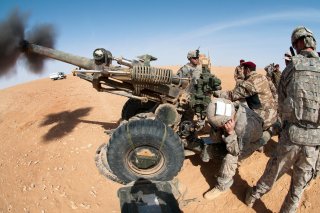The U.S. Army Is More Than Doubling the Range of Standard Artillery
This range extension is thanks to the Extended Range Cannon Artillery program.
Here’s What You Need to Remember: Now, the Army is taking this technology several steps beyond this by not only more than doubling the range of standard 155mm artillery through a program known as Extended Range Cannon Artillery which has hit targets at 70km, but also through an effort to engineer what’s called a “shaped trajectory” Excalibur round.
Although GPS-guided precision artillery burst onto the Army war scene in Iraq in 2007 with Excalibur shells, artillery has historically been an “area weapon” intended to blanket enemy positions with incoming fire to enable forces to maneuver in warfare.
The advent of precision changed this equation and given warzone commanders new options to find and “precisely” destroy fixed enemy ground targets from ranges out to 30km. This change is a major technical leap which greatly improved counterinsurgency warfare in Iraq for many years. The same phenomenon was quite relevant in Afghanistan with related precision weapons such as the Guided Multiple Launch Rocket System (GMLRS), a GPS guided missile able to destroy targets out to 80km. Upon several occasions, the GMLRS was used to destroy high-valued Taliban targets.
Now, the Army is taking this technology several steps beyond this by not only more than doubling the range of standard 155mm artillery through a program known as Extended Range Cannon Artillery which has hit targets at 70km, but also through an effort to engineer what’s called a “shaped trajectory” Excalibur round.
Brig. Gen. John Rafferty, who Directs the Army’s Long Range Precision Fires Cross Functional Team for Army Futures Command, told The National Interest that service weapons developers are now refining “flight software” for the shaped charge to better enable them to adjust course in flight. What this means, as he describes is, is that an Excalibur round is, through software upgrades, acquiring an ability to destroy otherwise obscured or unreachable targets.
“We are working on flight software that enables Excalibur to adjust its trajectory. It has fins in the back and in the front, so it is steerable. We are changing the software so that it can overcome what are normally indirect fire limitations when it comes to what we call intervening crests,” Raffery told The National Interest in a recent interview.
As examples, Rafferty said the shaped charge might be able to destroy a target that is hidden in a cave or beneath some kind of overhead cover.
What if an enemy tank were parked under a bridge or behind a ridge, Excalibur might typically be challenged to destroy it, even if its location were identified in some way. Excalibur 155mm rounds descend directly or in a more linear way, yet a “shaped trajectory” round can be pre-programmed by an observer to perform a “high-G-U-turn” to alter its course in flight.
“When it gets to the highest point in its trajectory, the canards are deployed and the body gives it lift and glide. Then it separates from what a conventional round looks like. With a shaped trajectory you can ‘bend that trajectory,’” Shawn Ball, Excalibur Business Development lead, Raytheon, told The National Interest in an interview last year.
Kris Osborn serves as Defense Editor for The National Interest. He previously served at the Pentagon as a Highly Qualified Expert with the Office of the Assistant Secretary of the Army - Acquisition, Logistics & Technology. Osborn has also been an anchor and on-air military analyst for national TV networks.
This article is being republished due to reader interest.
Image: Flickr.

